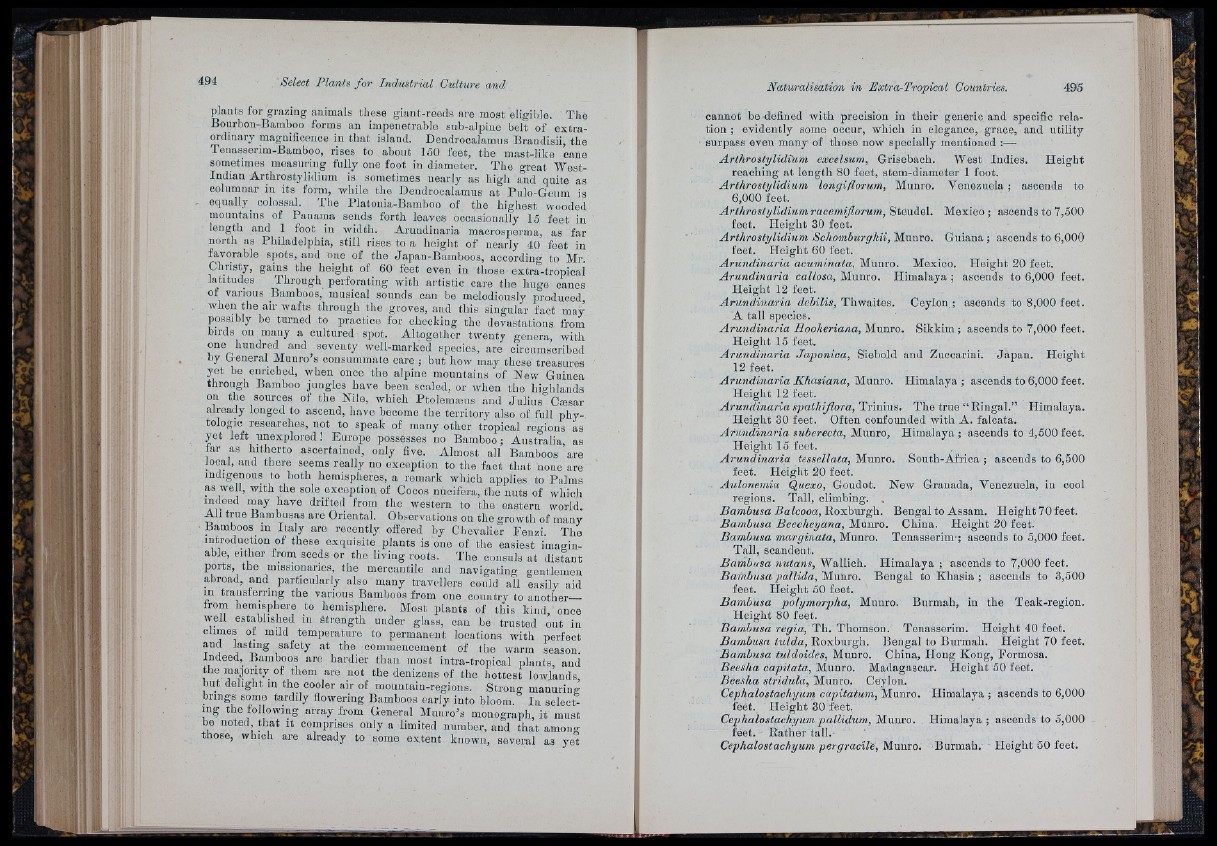
plants for grazing animals these giant-reeds are most eligible. The
Bourbon-Bamboo forms an impenetrable sub-alpine belt of ex traordinary
magnificence in tliat island. Dendrocalamns Brandisii, the
Teiiasserim-Bamboo, rises to about 150 feet, the mast-like cane
sometimes measuring fully one foot in diameter. The great West-
Indian Arthrostylidium is sometimes nearly as high and quite as
columnar in its form, while the Dendrocalamns at Pulo-Geum is
equally_ colossal. The Platonia-Bamboo of the highest wooded
mountains of Panama sends forth leaves occasionally 15 feet in
length and 1 foot iu width. Arundinaria maorosperma, as far
north as Pliiladelphia, still rises to a heiglit of nearly 40 feet in
favorable spots, and ono of the Japan-Bamboos, according to Mr
Christy, gains tbe height of 60 feet even iu those extra-tropical
latitudes Through perforating with artistic care the huge canes
of various Bamboos, musical sounds can be melodiously produced,
when the air wafts through the groves, and tliis singular fact may’
possibly be turned to practice for cheeking the devastations from
birds on many a cultured spot. Altogether twenty genera, with
one hundred and seventy well-marked species, are circumscribed
by General Munro’s eonsummate care ; but how may these treasures
yet be enriched, when once the alpine mountains of New Guinea
throngh Bamboo jungles have been scaled, or when the highlands
on the sources of the Nile, which Ptolemæiis and Julius Cæsar
already longed to ascend, have become the territory also of full pliy-
tologic researches, not to speak of many other tropical regions as
yet left unexplored ! Europe possesses no Bamboo ; Australia as
far as hitherto ascertained, only five. Almost all Bamboos are
Jocal, and there seems really no exception to the fact th a t none are
indigenous to both hemispheres, a remark which applies to Palms
as well, with the sole exception of Cocos nucifera, the nuts of wliieh
indeed may have drifted from the western to the eastern world.
All true Bambusas are Oriental. Observations on the growth of many
Bamboos in Ita ly are recently offered by Chevalier Fenzi. The
introduction of these exquisite plants is one of the easiest imaginable,
either from seeds or the living roots. The consuls at distant
ports, the missionaries, the mercantile and navigating gentlemen
abroad, and particularly also many travellers could all easily aid
m transferring the various Bamboos from one country to another—
from hemisphere to lieiiiisphere. Most plants of this kind, once
well established in strength under glass, can be trusted out iu
climes of mild temperature to permanent locations witli perfect
“ ®Lug safety a t the commencement Of the warm season.
Indeed, Bamboos are hardier than most iiitra-tropical plants, and
the majority of them are not the denizens of the hottest lowlands
but delight in the cooler air of mountain-regions. Strong manuring
brings some tardily flowering Bamboos early into bloom. In select'
mg the following array from General Munro’s monograph, it must
be noted, th a t it comprises only a limited number, and th a t amoiiu
those, which are already to some extent known, several as y et
cannot be defined with precision in their generic and specific relation
; evidently some occur, which in elegance, grace, and utility
surpass even many of those now specially mentioned :—
Arthrostylidium excelsum, Grisebach. West Indies. Height
reaching at length 80 feet, stem-diameter 1 foot.
Arthrostylidium longiflorum, Munro. Venezuela ; ascends to
6,000 feet.
Arthrostylidium racemiflorum, ^tendel. Mexico; ascends to 7,500
feet. Height 30 feet.
Arthrostylidium Schomburghii, Munro. Guiana ; ascends to 6,000
feet. Height 60 feet.
Arundinaria acuminata. Munro. Mexico.
Height 20 feet,
Arundinaria callosa, Munro. Himalaya ;
ascends to 6,000 feet.
Height 12 feet.
A ru n d in a ria debilis, Thwaites. Ceylon,;
ascends to 8,000 feet.
A tall species.
Arundinaria Hookeriana, Munro. Sikkim ;
ascends to 7,000 feet.
Height 15 feet.
Arundinaria Japónica, Siebold and Zuccarini.
Japan. Heiglit
12 feet.
A rundinaria Khasiana, Munro. Himalaya ; ascends to 6,000 feet.
Height 12 feet.
Arundinaria spathiflora, Trinius. The true “ Eingal.” Himalaya.
Height 30 feet. Often confounded with A. falcata.
Arundinaria suberecta, Munro, Himalaya ; ascends to 4,500 feet.
H eight 15 feet.
Arundinaria tessellata, Munro. South-Africa ; ascends to 6,500
feet. Height 20 feet.
Aulonemia Quexo, Goudot. New Granada, Venezuela, in cool
regions. Tall, climbing. ,
Bambusa Balcooa,Hocihwgb. Bengal to Assam. Height 70feet.
Bambusa Beecheyana, Munro. China. Height 20 feet.
Bambusa marginata, Munro. Tenasserim’; ascends to 5,000 feet.
Tall, scandent.
Bambusa nutans, Wallich. Himalaya ; ascends to 7,000 feet.
Bambusa pallida, Munro. Bengal to Khasia ; ascends to 3,500
feet. Height 50 feet.
Bambusa polymorpha, Munro. Burmah, in the Teak-region.
Height 80 feet.
Bambusa regia, Th. Thomson. Tenasserim. Height 40 feet.
Bambusa tulda, Roxburgh. Bengal to Burmah. Height 70 feet.
Bambusa tuldoides, Munro. China, Hong Kong, Formosa.
Beesha capitata, Munro. Madagascar. Height 50 feet.
Beesha stridula, Munro. Ceylon.
Cephalostachyum capitatum, Munro. Himalaya ; ascends to 6,000
feet. Height 30 feet.
Cephalostachyum pallidum, Munro. Himalaya ; ascends to 5,000
feet. Rather tall.
Cephalostachyum pergracil'e, Munro. Burmah. Height 50 feet.